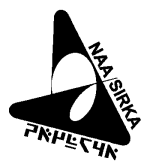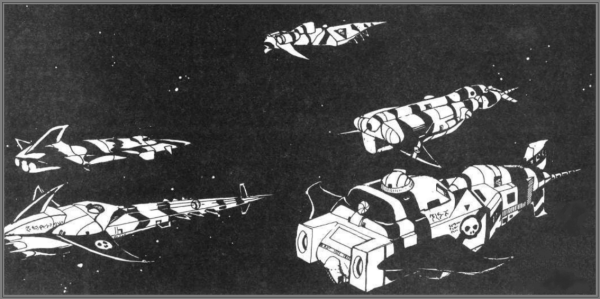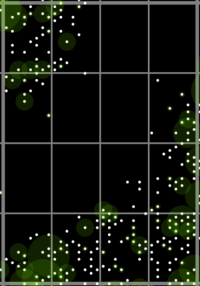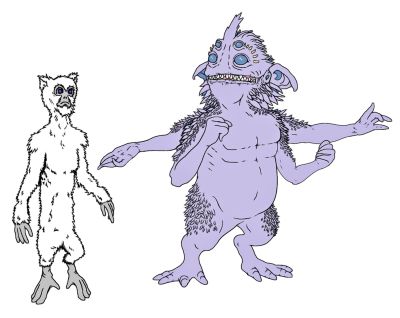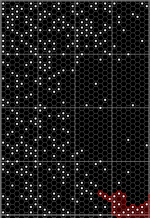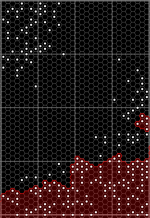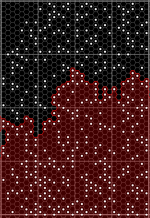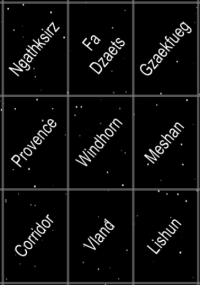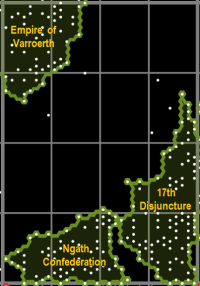Windhorn Sector
| Windhorn Sector | |||||||||||||||||
|---|---|---|---|---|---|---|---|---|---|---|---|---|---|---|---|---|---|
| |||||||||||||||||
| Subsectors | |||||||||||||||||
| |||||||||||||||||
| Sector Data | |||||||||||||||||
| No. of Worlds | 220 | ||||||||||||||||
| Population | 278,634 million | ||||||||||||||||
| Majority Control | 17th Disjuncture - 43% | ||||||||||||||||
| Secondary Control | Ngath Confederation - 31% | ||||||||||||||||
| Tertiary Control | Empire of Varroerth - 23% | ||||||||||||||||
| Quaternary Control | Non-aligned, Vargr - 3% | ||||||||||||||||
| Domain | Vargr Extents | ||||||||||||||||
| Capital | Various | ||||||||||||||||
| Gross Sector Product | BCr1,059,784 | ||||||||||||||||
| Trade Volume | BCr5,152 | ||||||||||||||||
| Imperial Coordinate | -1 / +2 | ||||||||||||||||
| This sector has a trade map | |||||||||||||||||
| This sector has economic data | |||||||||||||||||
| This sector has sector data | |||||||||||||||||
| This sector has a climate file | |||||||||||||||||
| This sector has sector data | |||||||||||||||||
|
Windhorn style="width: 250px; height: 350px; border: solid 1px black; float: right; clear: left" | |||||||||||||||||
Windhorn Sector is a turbulent Vargr-dominated region lying along the coreward border of the Third Imperium.
- It is solidly Vargr Space and part of the Vargr Extents.
- It is known as Gotsdzo Sector to the Vargr, a name that loosely translates as "Domain of Pale Stars".
- It was called Kishadikhu Sector during the Ziru Sirka.
Description (Specifications)
Windhorn Sector is both named after and best known for the presence of the Windhorn Rift, a major astrographic feature.
The sector lies directly to coreward of the Third Imperium.
- Parts of it were once held by the Ziru Sirka and later administered by the Rule of Man.
- Some ambitious Imperial Nobles still consider the sector's rimward subsectors part of the Domain of Vland, even though no official Imperial possession exists.
Astrographic Features
The following astrographic and commercial data regarding the sector has been determined:
- The center of the sector is a rift density region: parts of the spinward-coreward and rimward-trailing quadrants are standard stellar density regions.
- The brightest star in the sector is the unstable red giant primary of the Gaedueng system. It is sometimes called the Eye of the Rift.
- Two major trade routes terminate within the region: the Vilani Main and the Nudashiir Lagani.
- The Kanae-Figorurzaz Trade Run, the Vedhaaez Cluster, and the Gvuekh Cluster are important local trade routes lying within the rimward parts of the sector.
Stellar Distribution
A basic map showing the distribution and size of stars within Windhorn Sector.
- The color corresponds to the visible color of the star, which links to its spectral classification.
- The size as shown indicates both the physical size of the object and its relative brightness.
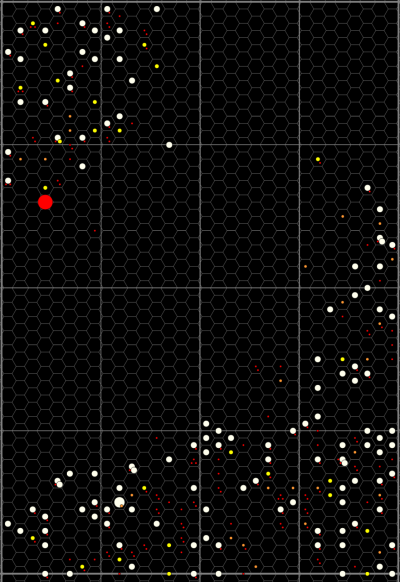
(Chart sourced from Traveller Map).
Note that the stars as depicted are representative. Any star, no matter what its size, is a mere speck within the hex it occupies.
- Ordinary main sequence stars can barely be seen from even a hex away.
- Huge, intensely luminous giant stars can be seen from across the sector and far beyond.
- The sector contains an unusually high number of white main sequence stars, an astronomical phenomenon some authorities believe to be related to the presence and nature of the Windhorn Rift.
Rifts and Voids
The sector forms the central-rimward part of the Windhorn Rift.
- The rift hinders travel and commerce across the region.

(Chart sourced from Traveller Map)
Locally at least, a rift is an astrographic concept based on Jump Drive performance.
The boundaries of rifts were established centuries ago, when the highest commonly encountered tech level was TL–12.
- This level of technology allowed the routine use of up to Jump-3 drives.
- Areas that couldn't be crossed by Jump-3-capable vessels were denoted as rifts.
This traditional definition of rift regions remains in use today: while modern high performance starships can easily cross them, most commercial vessels continue to utilize Jump-3 or less drives. Because of this most traffic is concentrated within higher stellar density regions, and as such the classic definition and boundaries of rift regions remains relevant.
A simple map showing the general extent of the Windhorn Rift.
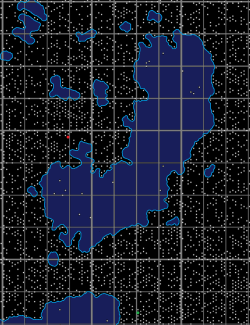
(Chart sourced from Traveller Map.)
Economic Astrography
Corporations
Several major corporations operate within the sector:
- Most goods that are transported around the rimward edge of the Windhorn Rift are carried by Gzugzo Lines, a sector-wide company that also extends services into Provence Sector.
- Menderes Corporation, based in the Julian Protectorate far to trailing, operates within the region.
- The Imperial Megacorporation Naasirka, with strong historical ties to the area, maintains a significant presence within the sector.
Vargr Corsairs
Vargr Corsair bands can pose a considerable risk to interstellar trade and commerce within the sector.
- Corsairs can often be negotiated with and many accept tribute in return for safe passage through their territory.
- Vessels and crews are advised to travel armed and ready to defend themselves.
Trade Routes
A number of trade routes exist within this area. Of these, the most important are:
The Nudashiir Lagani
A few worlds within the rimward-trailing corner of the sector lie on the Nudashiir Lagani, the great Lishun-Gashikan Main.
- An eclectic mix of vessels, both human and Vargr, work their ways along the Main, carrying vast amounts of goods and commodities between its member worlds.
- The sector lies on the far spinward end of the main.
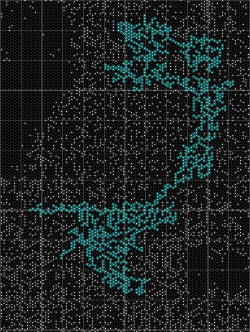
(Chart sourced from Traveller Map)
- The trailing subsectors of Windhorn Sector are depicted central left.
- Worlds on the Main are highlighted in green.
The Vilani Main
The sector marks the coreward end of the Vilani Main, the mighty trade artery of the Ziru Sirka.
- High cargo capacity, low jump rating vessels move along the Main, carrying vast amounts of goods and commodities between its member worlds.
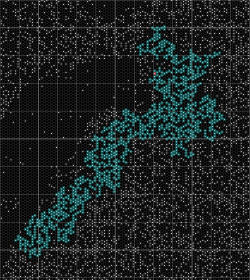
(Chart sourced from Traveller Map)
- The rimward subsectors of Windhorn Sector are depicted top-center.
- Worlds on the Main are highlighted in green.
- Vland is marked in red.
The Kanae-Figorurzaz Trade Run
The rimward subsectors of the sector contain a small Main called the Kanae-Figorurzaz Trade Run. The Main has 28 member worlds.
- It runs between Aekhgal Subsector, Gvadhoe Subsector, and Voenggaks Subsector.
- It lies entirely within the Ngath Confederation, a Vargr polity.
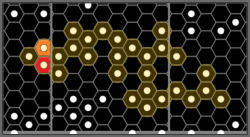
(Chart sourced from Traveller Map)
- Worlds lying on the Main are highlighted in tan.
- Kanae is marked in red.
- Figorurzaz is marked in orange.
The Vedhaaez Cluster
The rimward-trailing worlds of the sector are members of the Vedhaaez Cluster, a trade route running between Corridor Sector, Vland Sector, and Windhorn Sector. It is a small Main.
- It has 39 member systems.
- A few of its coreward worlds lie within the Ngath Confederation, a Vargr polity.
- Some of its rimward worlds are members of the Imperium.
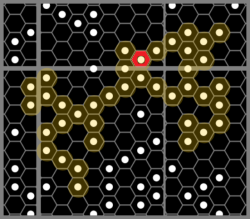
(Chart sourced from Traveller Map)
- Worlds lying on the Main are highlighted in tan.
- Vedhaaez, the namesake of the cluster and the capital of the Ngath Confederation, is marked in red.
The Gvuekh Cluster
The Gvuekh Cluster is a trade route running primarily between Voenggaks Subsector and Kishadiku Subsector. It has a few member worlds along the rimward edge of Sunggoe Subsector as well as a single world within Khuulu Subsector of Meshan Sector. It is a small Main.
- It has 42 member systems.
- It lies entirely within the borders of the 17th Disjuncture, a Vargr polity.
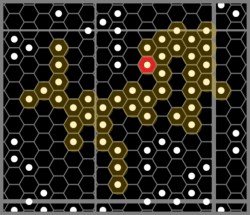
(Chart sourced from Traveller Map)
- Worlds lying on the Main are highlighted in tan.
- Gvuekhluerar, the primary world of the cluster and the capital of the 17th Disjuncture, is marked in red.
Tukogan Trade Circuit
The Tukogan Trade Circuit lies at the hub of three major local trade routes, the Gvuekh Cluster, the Khuulu Main, and the Nudashiir Lagani.
- Its primary world is Tukogan, in Khuulu Subsector of Meshan Sector.
- It is a fractious trade association made up of disparate interests, with links to many worlds and organizations.
- It facilitates trade and commerce across the region.
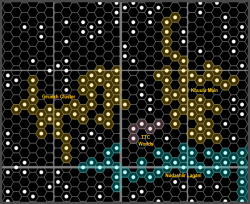
(Chart sourced from Traveller Map)
Windhorn Chain Jump Bridge
The Windhorn Chain is the name given to a proposed jump route across the Windhorn Rift. It would pass through Khonsu, Uroez, and Tsougak Subsectors of Windhorn Sector.
The concept is to construct a jump bridge, consisting of one or more deep space refuelling facilities located within Uroez Subsector, deep within the rift.
- The jump bridge would facilitate trade and travel between Provence Sector and Lair, the Vargr homeworld, and the Vargr-dominated sectors to trailing.
Proposed Designs
Two variant proposals exist: a jump-4 bridge and a jump-6 bridge.
A basic map showing the proposed location of the jump-4 Windhorn Chain Jump Bridge.
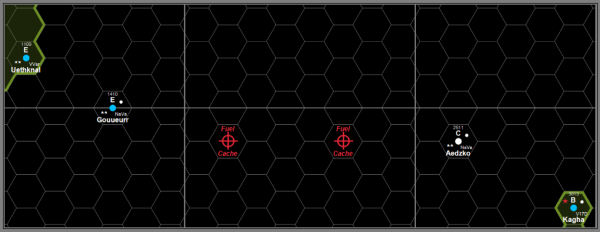
(Chart sourced from Traveller Map)
- The Bridge facilities would lie within interstellar hexes 1811 and 2211 of Uroez Subsector.
A basic map showing the proposed location of the jump-6 Windhorn Chain Jump Bridge.
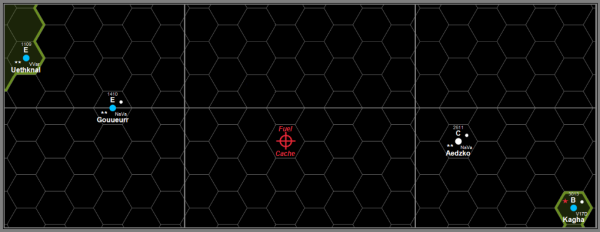
(Chart sourced from Traveller Map)
- The Bridge facilities would lie within interstellar hex 2011 of Uroez Subsector.
Issues and Concerns
Objections to the concept as proposed include:
- It would incur massive expenditure and require considerable amounts of materials to set up and get operational.
- It would require advanced ships, as well as support and maintenance facilities to keep them running. Few such ships are available within the extents.
Ownership and control of the proposed route is a contentious topic and negotiations to resolve it have been extremely fraught.
Despite these issues Gzugzo Lines, a major shipping interest within the sector, continues to support the idea.
Many believe that the jump bridge, in one of its two proposed forms, already exists.
World Listings
Comprehensive Second Survey UWP data for all worlds lying within the sector is available.
- The primary source material for all data is Traveller Map.
- Other sources may contain contradictory or incorrect information.
Note that some Second Survey data, though only 40 years old, is likely to be out of date.
- Data is occasionally updated as new information becomes available.
- Scouting missions gathering reliable, verified data can receive substantial payment.
- Verified updated data is constantly sought.
History & Background (Dossier)
The Vargr dominate the sector. They are divided into three notable political blocs:
- The coreward-spinward part of the sector, across the eponymous Windhorn Rift, is part of the Empire of Varroerth, the largest and most enduring polity within the Vargr Extents.
- On the rimward side of the sector, in space once held by the Vilani of the Ziru Sirka, two extensive nations are currently extant – the older Ngath Confederation and the more recently formed 17th Disjuncture. The Disjuncture is particularly belligerent and expansionistic.
Vargr are the majority population in all regions, though communities of mostly Vilani-descended Humans, wandering Hlanssai, long-entrenched Hhkar, and the sector's native Aezorgh can be found.
Native Sophonts
The following races (sophont species) are believed to have originated within this sector:
- Aezorgh of Soghzalghag. Clever and devious but physically small hexapods that are tolerated on most worlds rather than being seen as equals.
- They are ovoid, with wide tooth-filled mouths, two pairs of eyes (with each pair sensitive to different wavelengths of energy), four arms ending in four-fingered hands, two legs, and an outer covering of feather-like structures that serve to insulate the body.
- Their homeworld has long been occupied by the Vargr and the Aezorgh are now a small minority of the population. However, over the millennia, the species have spread throughout the rimward part of the Vargr Extents. There are significantly more offworld Aezorgh than there are on the homeworld.
- The name translates most literally as vermin.
Demographics
The total population of Windhorn Sector is estimated at 278.634 billion sophonts.
Significant populations of the following sophont races reside within this sector:
- Terragens (Non-human Terran races)
- Vargr (Major Race): the majority population within the sector.
- Humaniti (Human Races)
- Mixed heritage (Major Race): sparsely distributed across the sector.
- Solomani (Major Race): sparsely distributed across the sector.
- Vilani (Major Race): mainly found within those parts of the sector that were formerly part of the Ziru Sirka.
- Non-Human Races
- Aezorgh of Soghzalghag: native to the sector and sparsely distributed across the rimward parts of the Vargr Extents.
- Dhaen of Dhaen, in Provence Sector: small, long-bodied, fur-covered humanoids not recognized by the Vargr as being sophont.
- Some Vargr keep them as pets or as servants.
- Hhkar of Skkyhrk, in Amdukan Sector: very large, powerfully built, carnivorous, egg-laying, generally humanoid reptillianoids.
- The species have maintained small settlements and colonies in a broad sphere around their distant homeworld for millennia.
- There are long-established populations on Gvoezonakh, Khoodukhsoung, Roerragh, and Vaerrgkhir. Some of these predate the Ziru Sirka.
- Hlanssai of Vrirhlanz, in Gzaekfueg Sector: sensual, impulsive, emotional humanoids with a strong wanderlust who may occasionally be encountered in small groups.
- They are considered "unstable" by the notoriously unpredictable Vargr.
Linguistic Topography
The following languages are among the most commonly used within this astrographic region:
- Logaksu: a Vargr language widely spoken throughout all parts of the sector. It is the main language of the Empire of Varroerth.
- Ovaghoun: a Vargr language widely spoken within the Ngath Confederation and 17th Disjuncture.
- Mavek Errgh: The most common of the many local Vargr languages.
Other widely spoken languages include:
- Anglic: one of the two official languages of the Imperium.
- Vilani: one of the two official languages of the Imperium.
Occasionally heard:
Toponyms
This sector has been known by different names to different groups over its existence including the following:
| Windhorn Sector Names | ||
|---|---|---|
| Culture | Toponym | Polity |
| Third Imperium | Windhorn | Third Imperium |
| Aslan | Windhorn | Aslan Hierate |
| Droyne | Unknown | Droyne Oytrip Yatroy |
| Hiver | Gotsdzo | Hive Federation |
| K'kree | Unknown | Two Thousand Worlds |
| Solomani | Gotsdzo | Solomani Confederation |
| Vargr | Gotsdzo | Vargr Extents |
| Vilani | Kishadikhu | Third Imperium |
| Zhodani | Gotsdzo | Zhodani Consulate |
Faith and Belief
A number of religious faiths are followed within the sector:
- Church of the Chosen Ones (followed across the Vargr Extents).
- Faarzgaen-worship (followed within the coreward half of the sector.
- Senghik Outoun (scattered followers across the Vargr Extents)
- Taarskoism (followed across the sector).
Historical Eras
General Overview:
- First Diaspora
- Second Diaspora (the Vargr Pillaging)
- Sack of Gashikan (Second Empire of Gashikan)
- Wolvesbane Project (Vargr Race Wars / Gashikan Race Wars)
- Establishment of the Third Imperium
- Pacification Campaigns
- Julian Wars
- Vargr Campaigns
- Golden Age
Major Historical Events Timeline
Major events that have affected this sector and the wider region that it lies within:
- circa -10,000: The Hhkar begin to disperse from their homeworld. Some eventually settle in Windhorn Sector.
- -9235: the Vilani discover jump technology and begin to spread into the area.
- ca -8100: surviving records indicate wandering Vilani have established settlements within the rimward regions of the sector. There is trade amongst their worlds.
- -4045 to -2204: the Ziru Sirka claims and settles worlds across the region.
- -3810: the Vargr discover jump technology and begin an era of expansion.
- -2404 to -2215: the human Interstellar Wars rage to rimward. The region becomes increasingly neglected.
- -2400s: Vargr raiding into the region significantly increases. This becomes known as the Vargr Pillaging.
- -2204 to -1776: the Rule of Man nominally administers the rimward worlds of the region. Conflicts escalate between Vargr and humans as the Vargr occupy former Ziru Sirka territory.
- circa -1700: Vargr rimward expansion gradually ceases: the border between human and Vargr space stabilizes.
- -1776 to 0: the Long Night. There is widespread regression within the area and some worlds become barren.
- The Year 0: to rimward, the Third Imperium is founded.
- circa 26: the Empire of Varroerth is founded.
- 300-420: the Imperial First Survey charts Windhorn Sector: small Vargr polities exist within the region.
- late 800s: the Ngath Confederation begins to form and gradually absorbs neutral worlds and smaller polities.
- 995-1065: the Imperial Second Survey charts the Sector. Few humans remain within the region.
- circa 1040: the 17th Disjuncture is founded and rapidly brings neutral worlds under its banner, directly competing with the Ngath Confederation.
- 1065: the Second Survey is published. Information about the sector becomes widely available.
- 1100: no non-rift neutral worlds remain within the region.
Historical Charts
Simple charts showing Provence Sector, Windhorn Sector, and Meshan Sector (top row) and Corridor Sector and Vland Sector (bottom row) at the beginning of the Interstellar Wars, circa -2400.
- The Ziru Sirka's territories are marked in red.
- Almost nothing (except for a few names) is known of Vargr states of the period.
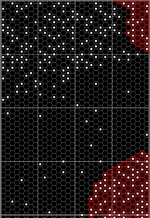
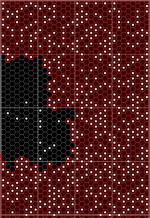
(Charts sourced from Traveller Map)
Worlds, Systems & Sectors (Political Astrography)
The Windhorn Rift is centered on the sector and extends both spinward and coreward.
Political Astrography
A number of broad astropolitical areas are found within Windhorn Sector:
- Vargr Extents: worlds and systems occupied by the Vargr or under the dominion of one of the three major Vargr polities within the region. Many worlds have small human communities and "infestations" of Aezorgh.
- Balkanized Space: regions containing non-aligned world-states. At present, only the interior of the Windhorn Rift qualifies as Balkanized Space. This is likely to change as allegiances shift, particularly within the unstable rimward parts of the sector lying along the coreward border of the Imperium.
Polity Listing:
The following polities can be found within this sector:
- Vargr Extents - (Vargr powers):
- 17th Disjuncture.
- Empire of Varroerth.
- Ngath Confederation. It is defended by the Ngath Confederate Space Navy.
- Non-Aligned Powers (World-States).
- Non-Aligned (Vargr-dominated).
- Other Powers
- Ziru Sirka (historical: -4045 to -2204).
- Rule of Man (historical: -2204 to -1776).
Polity Descriptions
Here are several synopses of the polities found in this sector:
- Alleg: NaVa: "Non-Aligned, Vargr-dominated"
- Alleg: V17D: "17th Disjuncture"
- Alleg: VNgC: "Ngath Confederation"
- Alleg: VVar: "Empire of Varroerth"
Capitals
- Goeghfoedh is the Empire of Varroerth capital of Dakoeng Subsector.
- Dharukeksoue is the Empire of Varroerth capital of Nanthou Subsector.
- Vedhaaez is the Ngath Confederation capital of Aekhgal Subsector.
- Allunsoeks is the Ngath Confederation capital of Gvadhoe Subsector.
- Ksalarrkfaegz is the Ngath Confederation capital of Khaellung Subsector.
- Okueallnurr is the 17th Disjuncture capital of Voenggaks Subsector.
- Vokhson is the 17th Disjuncture capital of Tsougak Subsector.
- Uangi is the 17th Disjuncture capital of Sunggoe Subsector.
- Thorrghgharz is the 17th Disjuncture capital of Kishadiku Subsector.
Imperial Territory
Nearly three millennia ago the rimward part of the sector was human dominated and controlled by the Ziru Sirka. It was lost to Vargr depredations.
- The whole region is controlled by non-Imperial powers.
- Some interests would like to see it returned to Imperial rule.
Sector Summary
The Windhorn sector has 220 worlds with an estimated population of 278 billion, a per capita income of Cr3,807, and a total economy is BCr1,058,617. These worlds originate an interstellar trade of BCr667 through 172 starports (38 Class A, 46 Class B, 68 Class C, 20 Class D) employing 91,345 people. Driving this interstellar trade are 36 Agricultural (Ag) worlds, 30 Non-Agricultural (Na) worlds, 25 Pre-Agricultural (Pa) worlds, 30 Pre-Industrial (Pi) worlds, 12 Rich (Ri) worlds, and 12 Industrial (In) worlds. The governments in Windhorn maintain 79 Naval bases, and 66 Corsair bases. The average technology level is 7 (with most between 4 and 10). The highest technology level is 14 at Akezaenae (Windhorn 1435) and Rugvuekafagh (Windhorn 2933).
The Windhorn sector contains 317 stars and 2,442 identified planets; 134 monostellar systems, 76 binary systems, nine trinary systems, and one system with four or more stars. 179 of the 220 systems (81%) have native gas giants. There are four Asteroid (As) belts, 11 Desert (De) worlds, 17 Garden (Ga) worlds, nine Ice-capped (Ic) worlds, 34 Poor (Po) worlds, 25 Vacuum (Va) worlds, and six Water (Wa) or Ocean (Oc) worlds.
Windhorn has an estimated population of 278 billion distributed across 17 High population (Hi) worlds, 25 Moderate population (Ph) worlds, 97 Non-industrial (Ni) worlds, 48 Low population (Lo) worlds, and five Barren (Ba) worlds. The highest population worlds are Tsaekfuu (Windhorn 3238), Dharukeksoue (Windhorn 0211), Vedhaaez (Windhorn 0740), Soghzalghag (Windhorn 1732), and Vokhson (Windhorn 3119). The population consists of 1 sophont groups.
| 1 identified sophont populations in Windhorn | |
|---|---|
Polities
17th Disjucture
The 17th Disjucture has jurisdiction over 94 worlds with an estimated population of 116 billion, a per capita income of Cr4,413, and a total economy is BCr511,992. These worlds originate an interstellar trade of BCr241 through 77 starports (14 Class A, 22 Class B, 34 Class C, 7 Class D) employing 34,950 people. Driving this interstellar trade are 14 Agricultural (Ag) worlds, eight Non-Agricultural (Na) worlds, 12 Pre-Agricultural (Pa) worlds, 11 Pre-Industrial (Pi) worlds, six Rich (Ri) worlds, and four Industrial (In) worlds. The governments in 17th Disjucture maintain 45 Naval bases, and 23 Corsair bases. The average technology level is 7 (with most between 4 and 10). The highest technology level is 14 at Rugvuekafagh (Windhorn 2933).
The 17th Disjucture has an estimated population of 116 billion distributed across six High population (Hi) worlds, 12 Moderate population (Ph) worlds, 38 Non-industrial (Ni) worlds, 26 Low population (Lo) worlds, and three Barren (Ba) worlds. The highest population worlds are Tsaekfuu (Windhorn 3238) and Vokhson (Windhorn 3119). The population consists of 1 sophont groups.
Ngath Confederation
The Ngath Confederation has jurisdiction over 69 worlds with an estimated population of 93 billion, a per capita income of Cr3,234, and a total economy is BCr302,522. These worlds originate an interstellar trade of BCr316 through 49 starports (15 Class A, 10 Class B, 18 Class C, 6 Class D) employing 42,840 people. Driving this interstellar trade are 14 Agricultural (Ag) worlds, 13 Non-Agricultural (Na) worlds, nine Pre-Agricultural (Pa) worlds, ten Pre-Industrial (Pi) worlds, three Rich (Ri) worlds, and five Industrial (In) worlds. The governments in Ngath Confederation maintain 27 Corsair bases, and 16 Naval bases. The average technology level is 7 (with most between 4 and 10). The highest technology level is 14 at Akezaenae (Windhorn 1435).
The Ngath Confederation has an estimated population of 93 billion distributed across seven High population (Hi) worlds, seven Moderate population (Ph) worlds, 35 Non-industrial (Ni) worlds, ten Low population (Lo) worlds, and one Barren (Ba) world. The highest population worlds are Vedhaaez (Windhorn 0740) and Soghzalghag (Windhorn 1732). The population consists of 1 sophont groups.
Empire of Varroerth
The Empire of Varroerth has jurisdiction over 52 worlds with an estimated population of 68 billion, a per capita income of Cr3,568, and a total economy is BCr244,016. These worlds originate an interstellar trade of BCr108 through 42 starports (8 Class A, 13 Class B, 14 Class C, 7 Class D) employing 13,500 people. Driving this interstellar trade are eight Agricultural (Ag) worlds, nine Non-Agricultural (Na) worlds, four Pre-Agricultural (Pa) worlds, nine Pre-Industrial (Pi) worlds, three Rich (Ri) worlds, and three Industrial (In) worlds. The governments in Empire of Varroerth maintain 18 Naval bases, and 14 Corsair bases. The average technology level is 7 (with most between 4 and 10). The highest technology level is 13 at Knoerorr (Windhorn 0310), Goeghfoedh (Windhorn 0502), and Gaedueng (Windhorn 0414).
The Empire of Varroerth has an estimated population of 68 billion distributed across four High population (Hi) worlds, six Moderate population (Ph) worlds, 23 Non-industrial (Ni) worlds, nine Low population (Lo) worlds, and one Barren (Ba) world. The highest population world is Dharukeksoue (Windhorn 0211). The population consists of 1 sophont groups.
Non-Aligned, Vargr-dominated
There are five Non-Aligned Vargr-dominated worlds in Windhorn with an estimated population of 43 million.
Summary of Subsectors
The following subsectors can be found within this sector:
| Subsector Name | Astrography | Allegiance | Summary | |
|---|---|---|---|---|
| Subsector A: | Dakoeng Subsector | Standard density | Empire of Varroerth. | Vargr territory since the earliest days of Vargr interstellar travel. Despite its proximity to the Vargr homeworld it has remained an isolated and underdeveloped backwater. |
| Subsector B: | Khonsu Subsector. | Sparse density. | Empire of Varroerth. | Vargr territory since the earliest days of Vargr interstellar travel. Despite its proximity to the Vargr homeworld it has remained an isolated and underdeveloped backwater. |
| Subsector C: | Urrgae Subsector | Rift density. | None. | Lying within the Windhorn Rift. |
| Subsector D | Urzkhoe Subsector | Rift density. | None. | Lying within the Windhorn Rift. |
| Subsector E: | Nanthou Subsector | Sparse density. | Empire of Varroerth. | Vargr territory since the earliest days of Vargr interstellar travel. Despite its proximity to the Vargr homeworld it has remained an isolated and underdeveloped backwater. |
| Subsector F: | Elours Subsector | Rift density. | None. | Lying within the Windhorn Rift. |
| Subsector G: | Uroez Subsector | Rift density. | None. | Lying within the Windhorn Rift. Proposed location of the Windhorn Chain Jump Bridge. |
| Subsector H: | Tsougak Subsector | Sparse density. | 17th Disjuncture. | The region was occupied by the Vargr prior to the Long Night and has remained Vargr-dominated since that time. |
| Subsector I: | Urarz Subsector | Rift density. | None. | Lying within the Windhorn Rift. |
| Subsector J: | Urkae Subsector | Rift density. | None. | Lying within the Windhorn Rift. |
| Subsector K: | Khaellung Subsector | Sparse density. | 17th Disjuncture. Ngath Confederation. |
The region was occupied by the Vargr prior to the Long Night and has remained Vargr-dominated since that time. |
| Subsector L: | Sunggoe Subsector | Standard density. | 17th Disjuncture. | A few worlds were part of the Ziru Sirka and nominally administered by the Rule of Man. It was overrun by the Vargr prior to the Long Night and has remained Vargr-dominated since that time. The rimward edge of the subsector is dominated by the Sunggoe Void, a minor rift region. A few of its rimward worlds are part of the Gvuekh Cluster. |
| Subsector M: | Aekhgal Subsector | Standard density. | Ngath Confederation. | Formerly a part of the Ziru Sirka and nominally administered by the Rule of Man. It was overrun by the Vargr prior to the Long Night and has remained Vargr-dominated since that time. It is the spinward end of the Kanae-Figorurzaz Trade Run. |
| Subsector N: | Gvadhoe Subsector | Standard density. | Ngath Confederation. | Formerly a part of the Ziru Sirka and nominally administered by the Rule of Man. It was overrun by the Vargr prior to the Long Night and has remained Vargr-dominated since that time. The region marks the coreward terminus of the Vilani Main. It forms the central part of the Kanae-Figorurzaz Trade Run. |
| Subsector O: | Voenggaks Subsector | Standard density. | 17th Disjuncture. Ngath Confederation. |
Formerly a part of the Ziru Sirka and nominally administered by the Rule of Man. It was overrun by the Vargr prior to the Long Night and has remained Vargr-dominated since that time. The region marks the coreward terminus of the Vilani Main. It is the trailing end of the Kanae-Figorurzaz Trade Run. It is the spinward end of the Gvuekh Cluster. |
| Subsector P: | Kishadiku Subsector | Standard density. | 17th Disjuncture. | Formerly a part of the Ziru Sirka and nominally administered by the Rule of Man. It was overrun by the Vargr prior to the Long Night and has remained Vargr-dominated since that time. The region marks the spinward terminus of the Nudashiir Lagani. It forms the central part of the Gvuekh Cluster. |
References & Contributors (Sources)
| This article is missing content for one or more detailed sections. Additional details are required to complete the article. You can help the Traveller Wiki by expanding it. |
| This article has metadata. |
- John Harshman, Marc Miller, Loren Wiseman. Classic Traveller Supplement 8 Library Data (A-M), (Game Designers Workshop, 1981), various pages. (Library data entries)
- John Harshman, Marc Miller, Loren Wiseman. Classic Traveller Supplement 11 Library Data (N-Z), (Game Designers Workshop, 1982), various pages. (Library data entries)
- J. Andrew Keith, Marc Miller, John Harshman. Vargr (Game Designers Workshop, 1984), IBC. (Sector named but no world data provided)
- James Holden, Joe D. Fugate Sr., Terrance McInnes. Vilani & Vargr (Digest Group Publications, 1990), pages 11, 48, 49. (Dot maps and charts showing the locations of the sector's worlds and political allegiances)
- Thom Gressman, J. Andrew Keith, Joe Fugate, Nancy Parker, Bill Hezeltine. The Flaming Eye (Digest Group Publications, 1990), pages 72-84, 90. (Details originally designed by Joe D. Fugate Sr.)
- David Burden, Stuart Dollar, Andy Lilly, Joseph Walsh. T4 Aliens Volume 1 (Imperium Games, 1998), pages 91-182. (The Vargr)
- David L. Pulver. GURPS Traveller Alien Races 1 (Steve Jackson Games, 1998), pages 64-99. (The Vargr)
- Simon Beal. Mongoose Traveller: Vargr, (Mongoose Publishing, 2009), various pages. (Background for the Windhorn Rift region)
- David Drazul, The 17th Disjuncture, archived in Freelance Traveller (Lecture Hall and Library) [1] (Core philosophy of the polity)
- Geir Lanessog. Alien Article: Aezorgh (Journal of the Travellers' Aid Society, 2022), Issue 11, page 61. (Details on the Aezorgh)
- Author & Contributor: Steve Bonneville (Consolidated list of subsector names)
- Author & Contributor: Peter Gray. External link: Traveller in the DED Zone (Index for Windhorn Sector)
- Author & Contributor: John G. Wood (Generated data)
- A full list of Wiki contributors can be found here.



